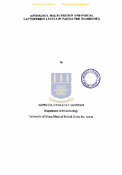UGSpace Repository
Aetiology, Malnutrition and Faecal Lactoferrin Levels in Paediatric Diarrhoea
JavaScript is disabled for your browser. Some features of this site may not work without it.
| dc.contributor.advisor | Newman, M.J. | |
| dc.contributor.advisor | Wilson, M.D. | |
| dc.contributor.advisor | Guerrant, R.L. | |
| dc.contributor.author | Opintan, J.A. | |
| dc.contributor.other | University of Ghana, College of Health Sciences, School of Biomedical and Allied Health Sciences, Department of Medical Microbiology | |
| dc.date.accessioned | 2015-11-13T09:48:52Z | |
| dc.date.accessioned | 2017-10-13T15:32:32Z | |
| dc.date.available | 2015-11-13T09:48:52Z | |
| dc.date.available | 2017-10-13T15:32:32Z | |
| dc.date.issued | 2011-08 | |
| dc.identifier.uri | http://197.255.68.203/handle/123456789/7131 | |
| dc.description | Thesis(PHd)-University of Ghana, 2011 | en_US |
| dc.description.abstract | Diarrhoea is a major public health problem that affects the physical and cognitive development of young children. Anthropometric data was collected from 274 children, 170 with diarrhoea and 104 without diarrhoea. Stool specimens were analyzed by conventional culture, PCR for EAEC, Shigella, Cryptosporidium, Entamoeba, and Giardia species, as well as by ELISA for faecal lactoferrin levels. Additionally, all E. coli recovered from culture were PCR screened for EAEC, and compared with those obtained from the stool DNA. Multiple gene loci (aaiC, aap, attA and aggR) were sought for EAEC. About 50% of the study population was mildly to severely malnourished. Mild to severe malnutrition (WAZ <-l), moderate to severe stunting (HAZ < -2) and moderate to severe wasting (WHZ < -2) were associated with diarrhoea (p = 0.023, 0.026 and 0.062, respectively). In only 1 of 170 diarrhoea stool specimen was Shigella flexneri recovered by culture. EAEC and Cryptosporidium were associated with diarrhoea (p = 0.048 and 0.011, respectively), and malnourished children who had diarrhoea were often co-infected with both Cryptosporidium and EAEC. About 27 % (4/15) C. parvum genotypes were identified by HRM analysis. Faecal lactoferrin levels were higher in children with diarrhoea (p = 0.019). Children who had EAEC infection, with or without diarrhoea had high mean lactoferrin levels irrespective of nutritional status. In conclusion, the current study identified high levels of growth deficits among the children with/without diarrhoea. The use of DNAbiomarkers revealed that EAEC and Cryptosporidium were common intestinal pathogens in Accra, and that elevated faecal lactoferrin was associated with diarrhoea in this group of children. EAEC’s dispersin gene (aap) was significantly associated with diarrhoea in both the faecal and bacterial DNAs, in the children studied (p < 0.05). Publication: Part o f the data presented in this thesis is published as follows: Opintan JA et al. (2010). Pediatric Diarrhea in Southern Ghana: Etiology and Association with Intestinal Inflammation and Malnutrition. Am J. Trop Med Hyg. 83: 936 - 943. | en_US |
| dc.format.extent | xvii, 943p. | |
| dc.language.iso | en | en_US |
| dc.publisher | University of Ghana | en_US |
| dc.title | Aetiology, Malnutrition and Faecal Lactoferrin Levels in Paediatric Diarrhoea | en_US |
| dc.type | Thesis | en_US |
| dc.rights.holder | University of Ghana |
